
Exercise in self-torture, take two
April 2nd, 2009
For those of you who weren't with me last fall, let me describe the exercise in self-torture:
It starts when you discover a migrant flock of Golden-Crowned Kinglets, very tiny, very cute birds with the activity level of chickadees on crack. The females have a bright yellow crown stripe. The males have an even brighter yellow crown stripe, plus a central stripe of the most beautiful vivid orange--but that part's usually hidden. He has to ruffle his crown feathers for you to see it.
You, the aspiring nature photographer, would like to get a half-decent picture of one of them, sitting still, in good light, with the golden crown visible. If you're really wishing, you'd like to catch a male showing off his orange. When you stand and watch these birds with binoculars you see them in all sorts of fetching poses, flashing their crowns every few seconds, so it seems a reasonable thing to wish for.
What you actually get is: smudgy distant photos, motion-blurred photos (lots of those), shadowed photos (because you tracked them into some dense thicket and there's not enough sun getting through), nice well-focused photos with no golden crowns visible, and photos with nothing in them, because the bird flew out of frame before you could push the button. You're there for hours. Every fifteen minutes or so, the whole flock suddenly disappears and goes you know not where. (Their voices are so soft that it is impossible to follow them by sound.) Fifteen minutes later they show up again, and you get another batch of bad pictures.
Finally, your patience gone, your morale shot, you're just about to throw in the towel, and then a Golden-Crowned Kinglet alights on a branch six feet away from you and just sits there. He tilts his head and shows off his crown. You lift the camera, focus, click, and by god, he sat still the whole time. Then you look at the picture on the LCD...and it's dark. It's blurry. The lighting was no good. You know why? Because you've been out here so long, trying to photograph these damn birds, that the sun set an hour ago.
At this point you smash your $600 zoom lens with a sledgehammer and go off to take up a more satisfying hobby, like stamp collecting.
Take two. The good news is, it's early April. These guys have made a long trip from as far south as Mexico and most of them have further to go yet. They're tired, perhaps finding it a little colder than they'd like, and they aren't doing much flycatching because there are few flying insects to speak of. This all means that their activity level is more of a "chickadee on espresso" than chickadee on crack. So while it was still an exercise in self-torture, it wasn't a complete loss.



This is somewhat of a turning point. It was kinglet season back when I first bought my new lens in autumn. Bird migration follows a "last in first out" rule, which means that the species still to come (of which there are tons) will be, for the most part, species I have never before had the chance to photograph. Exciting!
Wetland Robin
April 1st, 2009
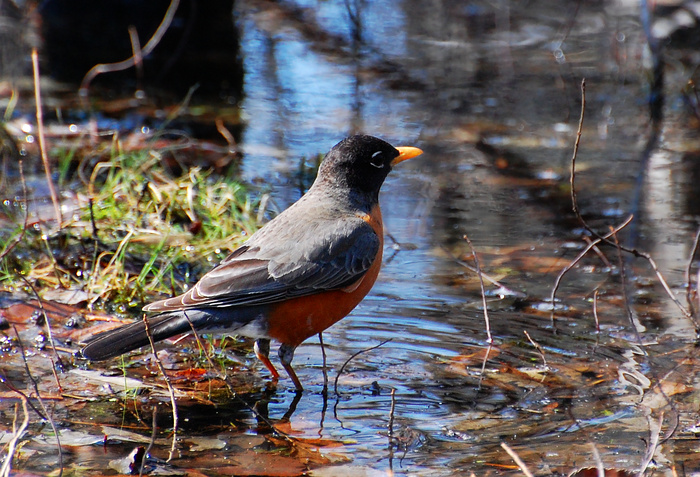
1680x1050 wallpaper
The Project
March 29th, 2009
I watched for some time as this Blue Jay poked, prodded, fussed and fiddled with what looked like an old leaf. Only when I studied the pictures back home did I realize it wasn't a leaf, though I'm still not sure what it was. Cocoon, maybe?

1680x1050 wallpaper
Blue Jays can be so gorgeous, it's hard to believe that they have no blue pigment in their plumage at all. But it's true: the color is caused by the structure of the feathers and the way light refracts through them. In other words, if you grind up a Blue Jay feather, it won't be blue anymore.
Wood Duck Strut
March 28th, 2009
Took a few friends out to Mud Lake today, and had a great time.
The wetland was still somewhat asleep, though with a growing patch of open water around the bridge and another near Cassels Road, and muskrats and beavers therein. Mallards, Black Ducks and Canada Geese were around. I told my companions about the beautiful Wood Ducks who breed on the pond, but that they hadn't migrated back yet.
Well, I spoke too soon. When I came back there later on my own, several pairs of Wood Ducks had arrived! They were skittish at first, but grew accustomed to my presence as I waited, and finally, one of the male/female pairs hopped up onto the hand railing to survey the area.
And then that male? Strutted it. Upright, crest poofed out, mating calls, the whole bit, as m'lady looked on adoringly. I'd complain that they weren't in a more natural setting when I shot this, but I think that would count as looking a gift bird in the mouth.
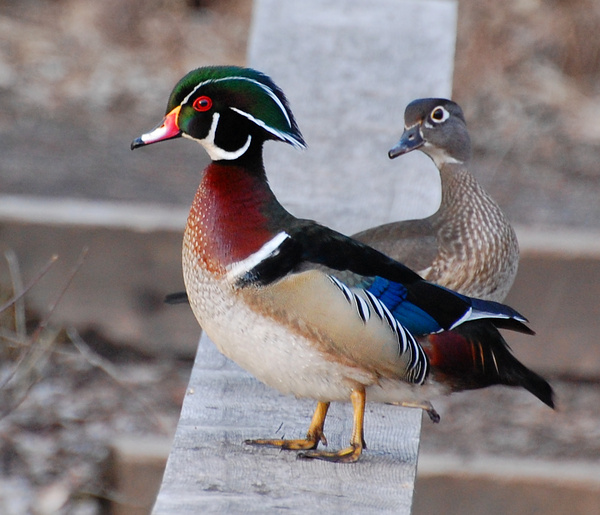
Here's another shot. The slicked-back appearance of the male's crest here is typical. (I had never before seen it poofed out the way it was in the previous picture.)
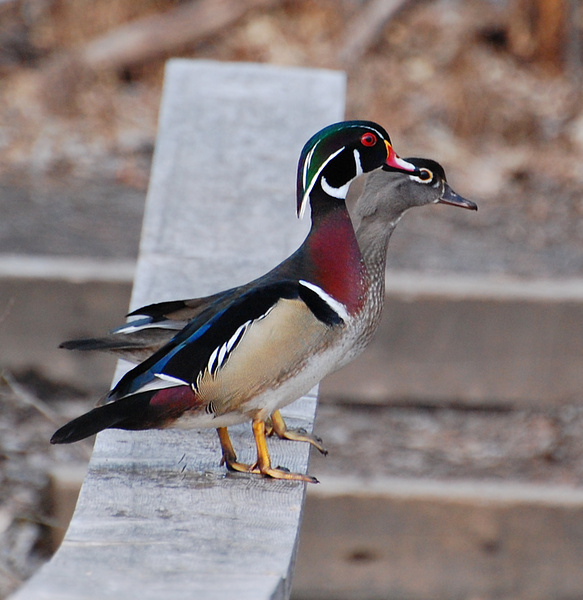
When a male Wood Duck is on the water, his whitish belly doesn't show. Only the "painted" parts show. He's as perfect as a faberge egg.
Pileated Woodpecker
March 24th, 2009
I decided to post this since at least one person thinks that the mushroom does not ruin the picture. And I guess Pileated Woodpeckers are magnificent enough that I'm willing to cut them some slack when it comes to composition!

She's female. You can tell because the sideburns are black instead of red, and the red crest doesn't extend onto her forehead.
Speaking of woodpeckers, I'm amazed this tree is still standing:
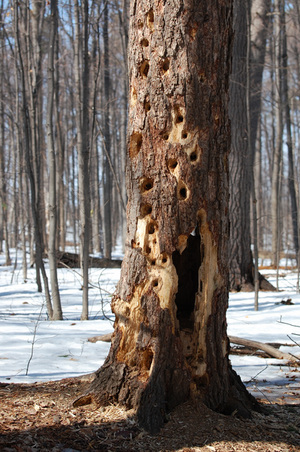
When a young drake's fancy...
March 22nd, 2009
On the Rideau today, two male Common Mergansers vied for the affections of a female, racing and chasing each other back and forth while she watched:
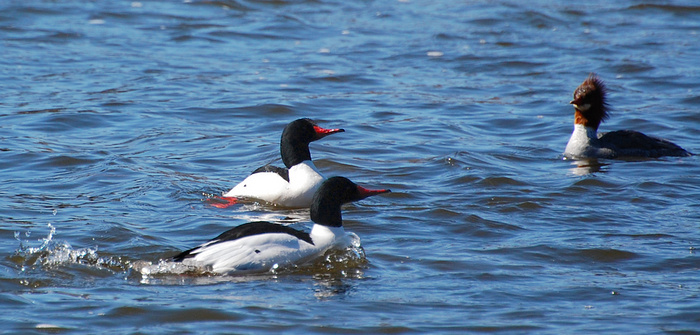
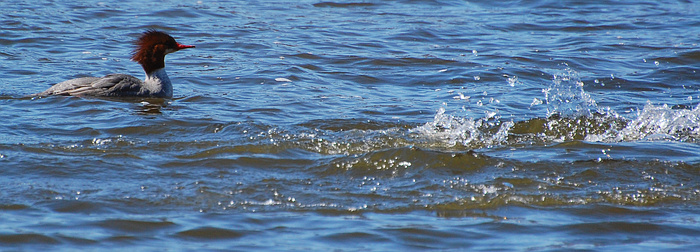
The phrase "boys, boys, boys" came to mind.
Some days...
March 21st, 2009
Took the camera out to Mud Lake Friday. Unfortunately it was one of those days when my best intentions turned to naught. Saw newly arrived Common Grackles and Song Sparrows, but no decent pictures of either one. Got a picture of a House Finch looking singularly ill-tempered, a chickadee picture that didn't quite work, and a gorgeous Pileated Woodpecker with a great honkin' mushroom blocking the view.
But all was not lost. Because I got this chipmunk in glorious hi-res:

1680x1050 wallpaper
Common Goldeneyes impress the ladies
March 20th, 2009
The goldeneyes on the Rideau are courting in earnest.
Goldeneye courtship generally means a small group of restless drakes swimming with one or two females. The males crane their necks, arch their necks, and occasionally, very suddenly (like a tic), pop their necks all the way back. That last maneuver is often followed by a "squeak-squeak" sound and a splash of water.
Meanwhile, the females mill around looking quite unimpressed by the whole affair. But they eventually choose their mates. The choice is made on the wintering grounds, with each pair migrating back to their breeding grounds together.
Last year, during which hundreds of them wintered on the Rideau, this was a downright extravaganza. I remember walking along the shore at dusk, the water speckled with rafts of ducks, and the air filled with delicate "squeak-squeak" sounds. I could barely see them, but I knew very well what they were up to. I called it the goldeneye nightclub.
It's less of an extravaganza this time but still fun to watch.
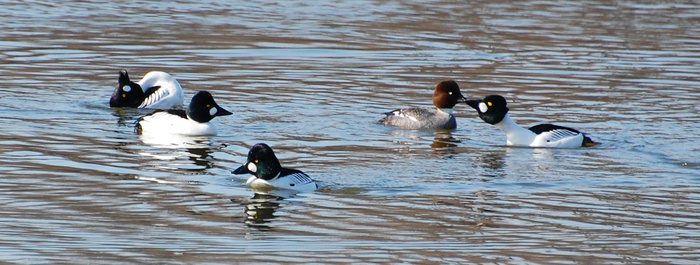



Welcome back, Red-Winged Blackbirds
March 18th, 2009
As expected and fondly anticipated, male Red-Winged Blackbirds have once again taken Mud Lake (and doubtless other marshes and wetlands) by storm. They'll be working on establishing their territories over the next few weeks. After that, the females arrive!
Of course, the redwing is one of those birds that anyone in Ottawa who wasn't born blind has seen many times. Nevertheless, such a beautiful creature deserves to have its arrival heralded. So:
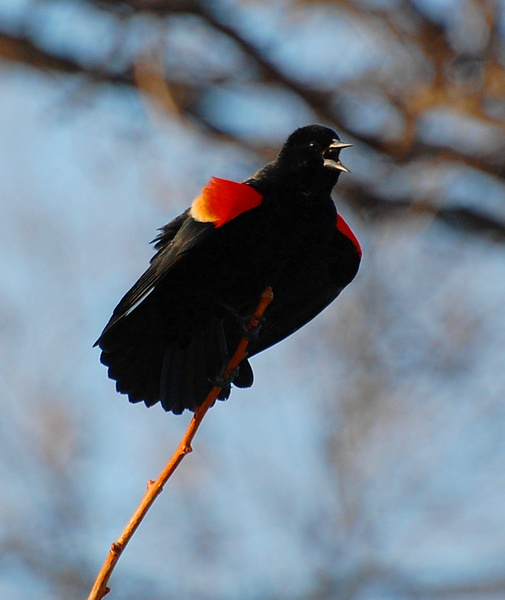
Early Spring Waxwings
March 15th, 2009
I went down to Mud Lake yesterday afternoon and was delighted to find nature waking up all over the place. Crows carrying nest material, robins and cardinals singing, chipmunks out of their burrows, Red-Winged Blackbirds freshly arrived from migration, and last but not least, waxwings galore.

1680x1050 wallpaper
In a brushy area near the outside fence of Mud Lake, a mixed flock of Cedar Waxwings and Bohemian Waxwings, along with a few robins, had staked out some small trees with last year's buckthorn berries. They clustered in taller trees and sallied down by ones or twos to pick the berries. The above was one of the Bohemians.
Another view of him:

Bohemian Waxwings have been here all winter, but these were the first I chanced to see since spring of 2008. The arboretum is often a good place to find them (they like crabapples). They'll be on their way out now, heading back to their breeding grounds in the far north.
Here are a couple of the Cedars:
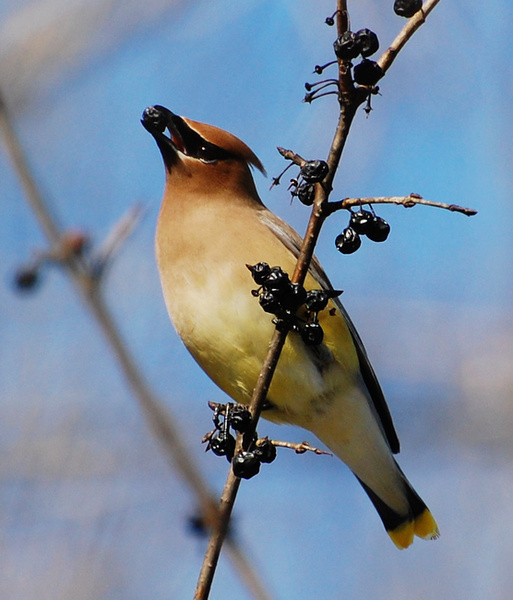
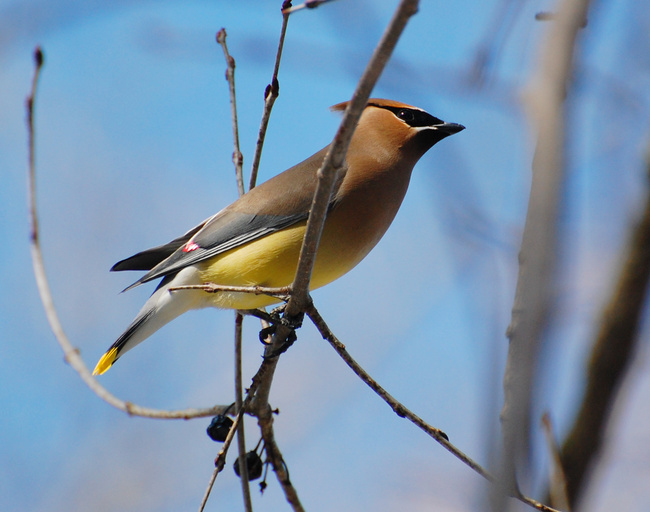
To me they're even more gorgeous. I love the warm gold of their bellies blending into brown. Fortunately for me, Cedar Waxwings are common breeders in our area!
Waxwings, collectively, are among the gentlest and gentlemanliest of birds. Their social structure is egalitarian. They never squabble. Naturalists have seen them line up on a branch and pass a berry from bird to bird. Each bird patiently passes it along, the last bird eats it, and then the ritual repeats until everyone is fed.
They are also jokingly known as the "party animals" of the avian world. In their eagerness to stuff themselves with berries in spring, they sometimes ingest fermented berries by mistake, and become quite drunk.
|
